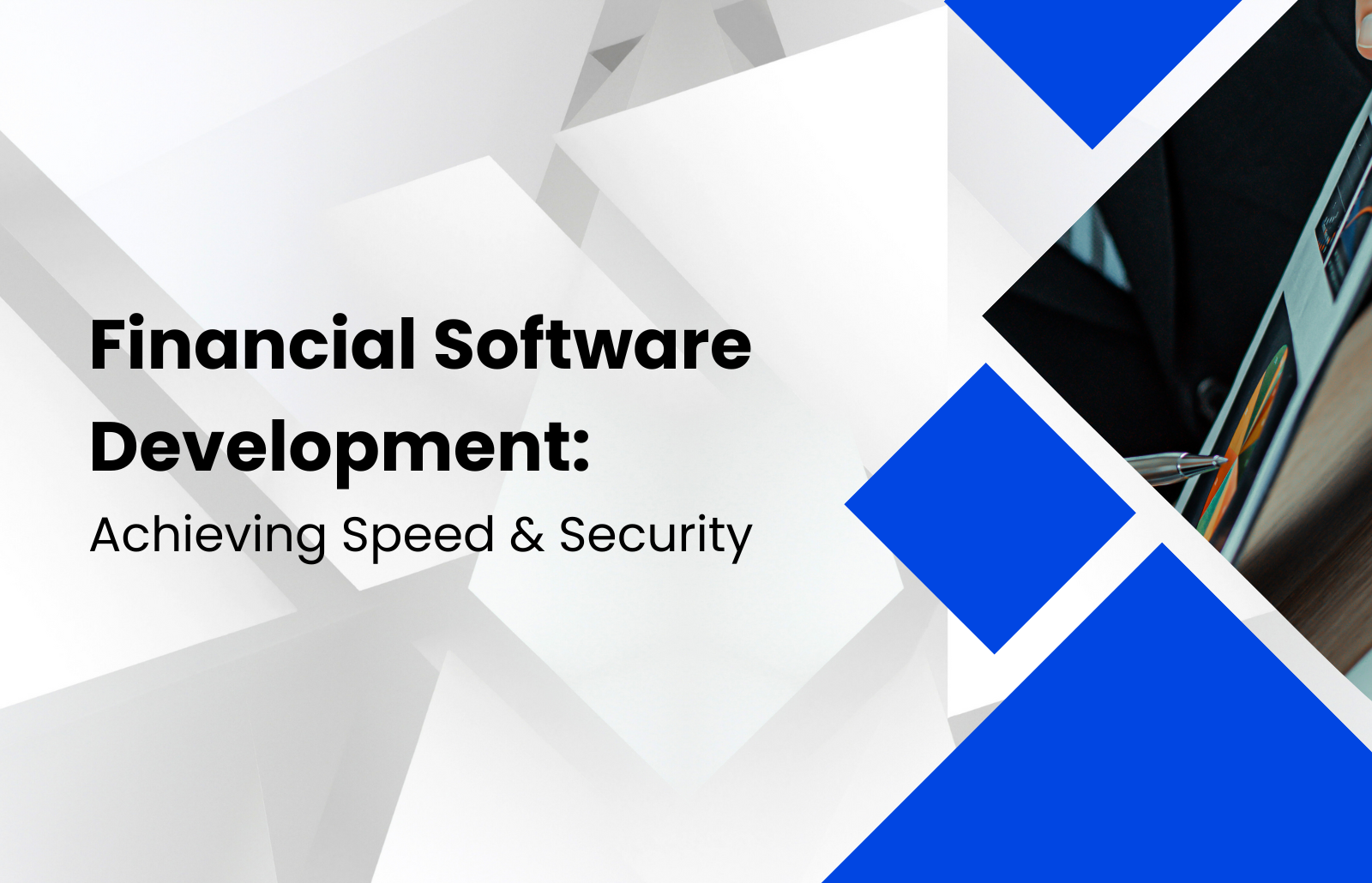The global financial software market is expected to reach a value of over £100 billion by 2026, with a compound annual growth rate (CAGR) of around 8%. This demonstrates the increasing demand for financial software solutions.
In financial software development, speed, real-time services, reliability, and security are paramount. Financial institutions, fintech companies, and banks rely on cutting-edge technology to process transactions, manage data, and provide efficient services.
This article delves into the critical aspects of financial software development and how to achieve them, with a spotlight on a successful case study involving Fexco, Ireland’s leading Fintech solutions provider. Let’s explore how to achieve the delicate balance between speed and security!
Ingredients for Success in Financial Software Development
According to a study, financial institutions that adopt agile development methodologies can reduce their time to market by up to 50%. 86% of financial software applications contain at least one security vulnerability. 60% of financial institutions are using cloud-based development platforms.
In the fast-paced world of finance, time is of the essence. Swift and efficient transactions are not just desirable but essential to maintain a competitive advantage. Slow software can lead to lost opportunities and customer dissatisfaction. To achieve the necessary speed, you need to consider several critical factors:
1- The Importance of Speed
- Optimised Code
Writing clean and efficient code is not just a best practice; it can significantly improve processing speed. According to a 2022 survey by GoodFirms, an astonishing 61.60% of software development companies deliver financial software in a time period of 4-6 months. This emphasises the importance of efficient code in delivering solutions promptly.
- High-Performance Infrastructure
Investing in robust infrastructure is crucial. This includes adopting cloud-based solutions that can handle the demands of real-time financial operations. High-performance infrastructure is not only about speed but also scalability. Good infrastructure can help you adapt to changing demands without compromising performance.
- Parallel Processing
Implementing parallel processing is a game-changer. It allows you to carry out multiple tasks simultaneously, dramatically reducing execution times. McKinsey’s study found that companies investing in faster software development are more likely to achieve a competitive advantage.
2- Real-Time Services: A Necessity
Real-time services are no longer a luxury; they are a necessity in today’s financial landscape. Customers expect to have access to up-to-the-minute financial data and services. Achieving this level of responsiveness requires the following:
Data Streaming: Implementing data streaming technologies is key to providing real-time information to users. This is essential for staying competitive in a world where financial markets operate around the clock.
Low Latency: Minimising latency in data transfer and processing is vital. Even a tiny delay can result in significant discrepancies. A study by Forrester found that every 100ms reduction in latency can increase revenue by 1%, highlighting the financial impact of low latency.
3- Reliability is Non-Negotiable
Reliability is a non-negotiable requirement in financial software. Downtime or system failures can have catastrophic consequences. To ensure the level of reliability needed in the financial sector, consider the following:
Redundancy: Implementing redundant systems and backup solutions is crucial to minimise downtime. According to a 2023 report by Gartner, the average cost of downtime for financial institutions is a staggering $5,600 per minute, emphasising the financial impact of reliability.
Robust Testing: Thoroughly testing your software is essential to identify and eliminate potential issues before they affect users. A study by IBM found that 90% of IT professionals say that system failures have had a significant impact on their business.
4- Fortifying Security: The Bedrock of Financial Software
Security is the cornerstone of financial software. With the ever-present threat of cyberattacks and data breaches, protecting sensitive financial data is of utmost importance. To enhance security and protect this valuable information, consider the following:
Data Encryption: Using strong encryption protocols to protect data at rest and in transit is paramount. Security is not just about preventing breaches; it’s also about maintaining trust. A study by the Ponemon Institute found that the average cost of a data breach in the financial services industry is a substantial $9.41 million.
Access Control: Implementing strict access control measures to ensure only authorised personnel can access sensitive information is fundamental. It’s not just about protecting data; it’s also about meeting regulatory requirements and building customer trust.
Regular Audits: Conducting regular security audits and penetration testing is vital to identify vulnerabilities. A study by IBM found that 62% of financial institutions have experienced a data breach in the past year, highlighting the persistent threat to the financial sector.
The Fexco Case Study
Fexco, established in 1981, is a standout example of a company excelling in financial software development. They process over €14 billion in transactions annually, serving a broad spectrum of financial sectors. Here’s how they achieved their goals:
- Hiring Stellar Talent
Fexco struggled to find top-notch software professionals in Ireland. To overcome this, they contracted Zartis to assemble an extended development team.
- Replacing Legacy Software
Fexco aimed to modernise by migrating legacy applications to cloud-based solutions. Zartis helped migrate applications to Microsoft Azure and microservices, resulting in a more flexible and scalable system.
- Modernising Tech Stack
Investing in modern software applications was a priority. Zartis introduced new technologies, including Golang, Scala, Kubernetes, and Helm, to enhance Fexco’s tech stack.
The Solution: Steps to Success
In 2016, Fexco partnered with Zartis to achieve these business goals with the help of an extended development team. They took the following steps:
- Modernising the Tech Stack
Zartis initially assembled a team of fullstack developers from Spain. They migrated Fexco’s mature applications to the cloud, utilizing Microsoft Azure and microservices. The new application was written in Java, with Angular for the frontend.
- Creating a Central API
Zartis defined a software delivery lifecycle and introduced a new architecture and technology stack, accelerating the development of the Central API. This centralisation of data improved efficiency and consistency.
- Developing Cutting-edge Software
Further collaboration involved rewriting monolithic applications and leveraging micro-frontends, Angular, Scala, and Go for a digital signature project. This project aimed to revolutionise aviation equipment trading and financing with a secure platform and a searchable electronic ledger.
Testament to Success
The collaboration between Fexco and Zartis has spanned over six years, resulting in:
- Three key products: Delivery Platform, Central API, and GATS.
- Adoption of a new tech stack with Go, Java, Scala, Angular, and Docker.
- A team of 11 full-time developers working on the project.
- A transfer of expertise between both teams.
- Two deployments every day, highlighting a commitment to continuous improvement.
Strategies for Achieving Excellence
To attain these essential qualities, technology executives play a pivotal role. Here are some strategies they employ:
- Innovative Technologies: Embracing innovative technologies is a common practice. Keeping up with technology trends is essential to stay ahead in the competitive financial software landscape.
- Business Knowledge: Combining technology expertise with a deep understanding of financial business models and skills is crucial for designing software that caters to the specific needs of customers and companies.
- Strategic Planning: Strategic thinking is essential to create a technology roadmap that aligns with business objectives and customer experience expectations.
- Enhancing Customer Experience: Financial software must meet the business objectives and cater to the evolving needs of customers. Technology executives and senior executives work together to design products that enhance the customer experience, considering factors like community treatment and communication systems.
- Leadership Experience: Technology leaders take on leadership roles to steer internal operations and everyday operations toward the desired goals.
- Technology Infrastructure: Building and maintaining robust technology infrastructure is vital for delivering the speed, reliability, and security that financial software demands.
- Compliance with Legal Terms: The financial industry has strict regulatory requirements. Ensuring compliance with legal terms is paramount for software development.
- Collaboration with Industry Leaders: Collaborating in financial software development to bring in the necessary expertise where needed. It’s essential for a holistic approach. This collaboration typically occurs between technology teams within financial institutions and fintech companies and external partners such as consulting firms and software development specialists, who can bring in the necessary skills and experience to ensure a smooth and successful go-to-market.
As the financial sector leaves no room for error, especially in real-time products and services, it’s important to make sure that the software that is deployed is bulletproof from the get-go. An external partner can help companies achieve that through the collective experience of working with many financial institutions.
Balancing Act
According to a 2022 report by the Ponemon Institute, the average cost of a data breach for financial services organisations is $5.72 million. This is significantly higher than the average cost for all industries, which is $4.35 million. The same report found that 64% of financial services organisations have experienced a data breach in the past year.
Achieving the delicate balance between speed and security is no small feat. It requires strategic thinking, technical expertise, and leadership experience. Technology vision, coupled with a robust technology infrastructure, enables the development of secure and efficient financial software.
However, it is also important to note that speed is critical for financial software. A delay of even a few seconds can result in significant losses for organisations.
Leaders in technology management and strategic planners collaborate to create software that is both fast and impervious to threats. Attention to legal terms and compliance ensures that the software adheres to industry regulations and mitigates risks.
Tips for Balancing Speed and Security
Here are some practical tips:
- Use agile development methodologies. Agile development methodologies are designed to help teams deliver software quickly and efficiently. Agile teams work in short sprints, and they focus on delivering working software at the end of each sprint. This helps to ensure that new features are deployed quickly and that feedback from users can be incorporated early on.
- Use automated security testing tools. Automated security testing tools can help to identify security vulnerabilities in software early on. This can help to prevent security breaches and reduce the cost of fixing security vulnerabilities later on.
- Use cloud-based development platforms. Cloud-based development platforms can help to speed up the software development process and improve security. Cloud-based platforms offer a number of security features, such as data encryption, firewalls, and intrusion detection systems.
- Risk Assessment: Perform a risk assessment to determine which parts of your financial software require the highest security and which can prioritise speed.
- Education and Training: Regularly educate your development team on the latest security threats and best practices to keep security at the forefront of their minds.
Final Verdict
Financial software development is the driving force behind the financial industry’s success. It requires a unique blend of business skills, technical knowledge, and a deep understanding of the financial sector’s complexities. By focusing on achieving speed and security in tandem, companies can stay ahead in a highly competitive job market and effectively contribute to their digital transformation.
Learning from Fexco’s journey, investing in modern technology strategies and stacks, hiring top talent, and utilising robust security measures can help your financial software stand out in this competitive landscape.
Zartis: Your Partner in Achieving Excellence in Financial Software Development
We understand the significance of balance in financial software development. We’re ISO 27001 certified, and our engineers have GDPR training. With a track record of helping companies across various industries build high-performance, secure software solutions, we are well-equipped to assist financial institutions in their quest for excellence.
Our expertise in cutting-edge technologies and implementing robust security measures positions them as a valuable business partner. Zartis can be the key to staying ahead of the competition. If you’re looking to boost the efficiency and security of your financial software, don’t hesitate to get in touch with Zartis today! Check out our case studies to learn more about their services and explore how they can tailor solutions to your specific needs.
Let’s embark on this journey with Zartis into the world of financial software development, where technology and finance converge to shape the industry’s future.





